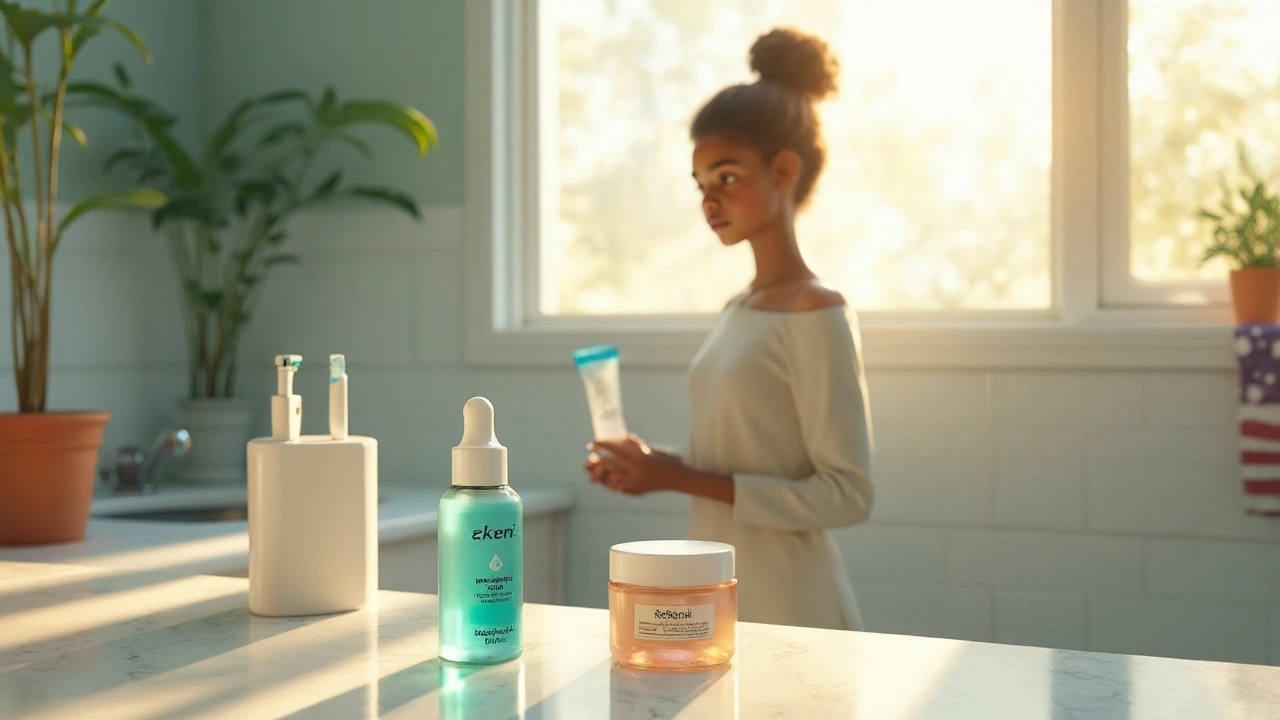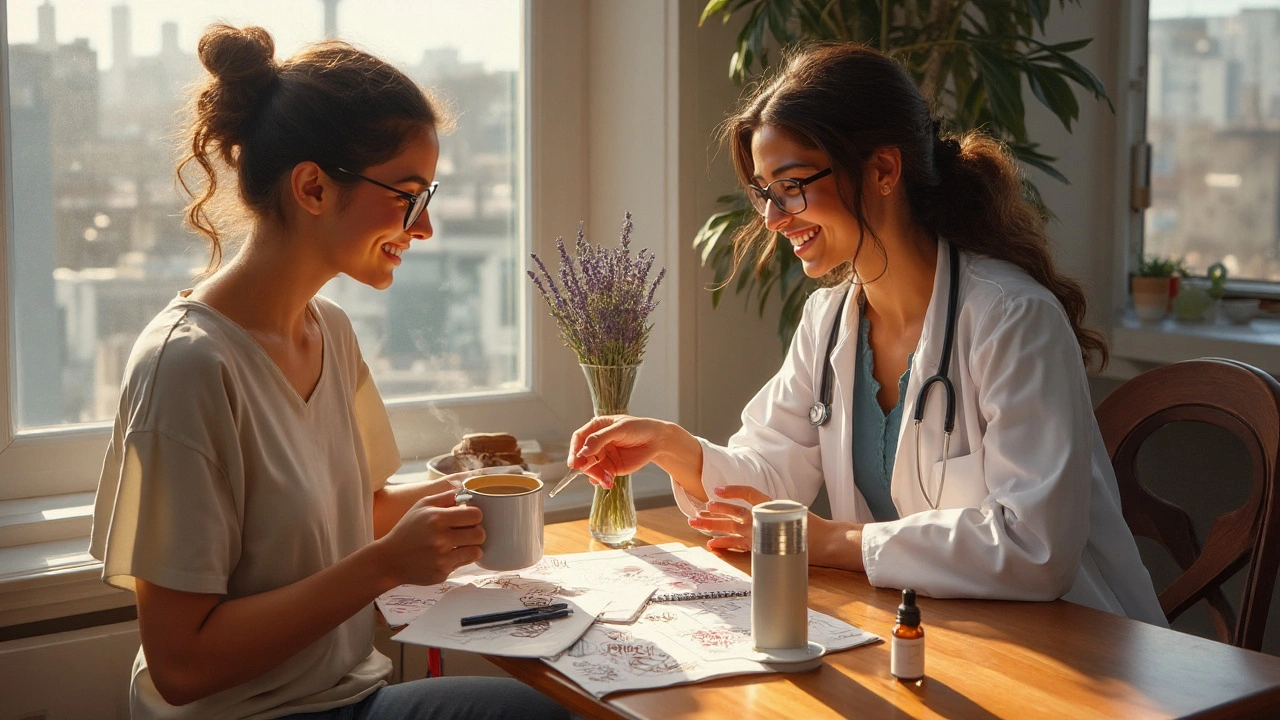
Acne Treatment Finder Quiz
Benzoyl peroxide is a topical oxidizing agent that releases oxygen to kill acne‑causing bacteria and unclog pores. Used in concentrations from 2.5% to 10%, it’s a staple in over‑the‑counter acne regimens and is often the first line of defence for mild to moderate breakouts.
How Benzoyl Peroxide Works
The core action of benzoyl peroxide is its ability to generate free radicals that oxidise Cutibacterium acnes (formerly Propionibacterium acnes). This reduces the bacterial load dramatically within 24‑48hours. Simultaneously, the compound has a mild keratolytic effect, loosening the dead‑skin “glue” that blocks pores. Because it does not rely on hormone pathways, resistance is rare, making it a reliable backbone for many acne protocols.
Popular Alternatives to Benzoyl Peroxide
While benzoyl peroxide is effective, different skin types or sensitivities may call for other actives. Below are the most common alternatives, each introduced with its own microdata markup.
- Salicylic acid is a beta‑hydroxy acid (BHA) that exfoliates inside the pore, dissolving oil and debris.
- Azelaic acid is a dicarboxylic acid with antibacterial and keratolytic properties, also helpful for rosacea.
- Niacinamide is a form of vitamin B3 that improves barrier function and reduces inflammation.
- Retinoids (e.g., adapalene) are synthetic vitamin A derivatives that normalise cell turnover.
- Tea tree oil is an essential oil with natural antimicrobial activity.
- Clindamycin is a topical antibiotic that targets acne bacteria without oxidising the skin.
- Sulfur is a mineral with keratolytic and antibacterial effects, often used in masks.
- Alpha hydroxy acids (AHAs) such as glycolic acid are water‑soluble exfoliants that smooth the skin surface.
Side‑by‑Side Comparison
| Active | Primary Mechanism | Typical Over‑the‑Counter Strength | Onset of Action | Irritation Risk | Best For |
|---|---|---|---|---|---|
| Benzoyl peroxide | Oxidising antibacterial + mild keratolysis | 2.5%-10% | 1-2days | Medium (dryness, peeling) | Inflammatory papules, oily skin |
| Salicylic acid | Exfoliates inside pores (BHA) | 0.5%-2% | 3-5days | Low‑Medium (dryness) | Blackheads, enlarged pores |
| Azelaic acid | Antibacterial + anti‑inflammatory | 10%-20% | 1-2weeks | Low (gentle) | Rosacea‑prone, post‑inflammatory hyperpigmentation |
| Niacinamide | Barrier reinforcement & anti‑inflammatory | 2%-5% | 2-4weeks | Very low | Sensitive skin, redness reduction |
| Retinoids (adapalene) | Normalises keratinisation | 0.1%-0.3% | 2-4weeks | Medium‑High (irritation, photosensitivity) | Comedonal acne, anti‑aging |

Choosing the Right Acne Warrior
Picking an active isn’t a numbers‑game; it’s about matching the product’s strengths to your skin’s needs.
- Oily, breakout‑prone skin: Benzoyl peroxide or salicylic acid are first‑line because they target excess sebum and blockages.
- Sensitive or redness‑prone skin: Azelaic acid and niacinamide are gentler, offering anti‑inflammatory benefits without the drying effect.
- Combination of comedones and inflammation: A retinoid paired with a low‑dose benzoyl peroxide can give both pore‑clearing and bacterial control, but introduce them gradually.
- Natural‑leaning routines: Tea tree oil (5%-10% dilution) or sulfur masks provide a milder antimicrobial punch, though evidence is less robust.
When layering actives, remember the “one‑active‑per‑application” rule: apply benzoyl peroxide in the morning, a retinoid at night, and keep soothing agents (niacinamide, hyaluronic acid) in between to mitigate irritation.
Practical Tips for Using Benzoyl Peroxide Effectively
- Start with the lowest concentration (2.5%). Apply a pea‑sized amount to the entire affected area, not just the blemish.
- Allow the product to dry for 5‑10minutes before layering moisturiser or sunscreen.
- Moisturise immediately after to counteract the drying effect; look for non‑comedogenic, Ceramide‑rich formulas.
- Use a broad‑spectrum SPF30+ daily. Benzoyl peroxide can make skin more photosensitive.
- Expect a “purge” phase - the first 1‑2weeks may see more visible pimples as the pores clear out.
- If severe redness or peeling occurs, cut back to every other day, then taper back up.
Related Concepts Worth Exploring
Understanding acne holistically can improve treatment outcomes. Consider digging deeper into:
- The role of sebum production and how diet influences it.
- Skin barrier health - why moisturisers matter as much as actives.
- How hormonal fluctuations (e.g., menstrual cycle) affect breakouts.
- Emerging laser and light therapies as adjuncts to topical regimes.
Next Steps for Readers
After you’ve settled on an active, give it at least 8‑12weeks before judging effectiveness - skin turnover is a slow process. Keep a simple log (date, product, any side‑effects) to spot patterns. If you’re still stuck after that period, a dermatologist can advise about prescription‑strength benzoyl peroxide or combination therapy.

Frequently Asked Questions
Can I use benzoyl peroxide and salicylic acid together?
It’s generally not recommended to layer two strong exfoliants on the same day because the skin can become overly irritated. If you want both, use benzoyl peroxide in the morning and salicylic acid in the evening, or alternate days.
Why does my skin feel dry after applying benzoyl peroxide?
The peroxide releases oxygen radicals that kill bacteria, and this oxidative reaction also strips away surface lipids, leading to dryness. Pairing it with a non‑comedogenic moisturizer restores the barrier and reduces flakiness.
Is benzoyl peroxide safe during pregnancy?
Current research classifies topical benzoyl peroxide as low risk (Category B). It’s not absorbed systemically in significant amounts, but many clinicians still advise sticking to gentler agents like azelaic acid if you have concerns.
How long does it take to see results?
Most users notice a reduction in active pustules within 3-5days, but visible improvement in overall skin texture can take 4-6weeks. Patience is key - acne clears gradually, not overnight.
Can I combine benzoyl peroxide with retinoids?
Yes, but introduce them slowly. Apply benzoyl peroxide in the morning and a retinoid at night, and start with a few times a week. Watch for excess redness; if it appears, reduce frequency or use a lower retinoid concentration.


Comments
Brittaney Phelps
If you’re fighting oily, breakout‑prone skin, start with the lowest benzoyl peroxide concentration and pair it with a lightweight, ceramide‑rich moisturizer. That combo keeps the dryness in check while the peroxide does its job.
Kim Nguyệt Lệ
The article correctly distinguishes the oxidative mechanism of benzoyl peroxide from the keratolytic action of salicylic acid.
Rhonda Adams
Love the “one‑active‑per‑application” rule – it really saves the skin from a burnout. 👍 Start your morning with a pea‑sized dab of benzoyl peroxide, wait ten minutes, then lock in moisture. In the evening you can swap to a retinoid or niacinamide, but keep the barrier creams consistent. If you notice flaking, just add an extra layer of a hyaluronic‑acid serum before the moisturizer. Consistency beats intensity every time.
Macy-Lynn Lytsman Piernbaum
Alright, let’s take a step back and think about acne like we’re philosophizing over a coffee. 🤔 First, every active is basically a tiny philosopher trying to convince your skin to behave differently. Benzoyl peroxide argues, “Kill the bacteria, free the pores!” while salicylic acid whispers, “Let’s exfoliate from the inside out, buddy.” Azelaic acid sits in the corner, quietly saying, “I’ll calm the inflammation and fade those dark spots, no drama.”
Now, if you stare at the ingredient list like it’s a cryptic poem, you’ll miss the bigger picture: skin health is a balance between microbes, oil, and the barrier. Over‑loading with three strong actives at once is like inviting three philosophers to a debate – you’ll end up with a chaotic argument and a broken barrier.
What works best is a simple routine where each player has its turn. Morning: low‑dose benzoyl peroxide + moisturizer. Evening: a gentle retinoid or niacinamide, followed by a barrier‑repair cream.
And remember, patience is a virtue. Acne clears at the pace of skin turnover – about four weeks for visible change, six to eight weeks for full results. So give each ingredient time to prove its thesis before you write a rebuttal. 🚀
Alexandre Baril
For those with dry or sensitive skin, start with azelaic acid or a low‑dose niacinamide. These keep the skin calm while still addressing bacteria and inflammation.
Stephen Davis
Imagine your skin as a garden. Benzoyl peroxide is the weed killer – it wipes out the nasty bugs fast, but you still need good soil (moisturizer) to keep the flowers (your skin) thriving. Pair it with a light, non‑comedogenic lotion and you’ll see the garden flourish without a barren look.
Grant Wesgate
Just a heads‑up: if you’re mixing a lot of actives, you might notice some tingling. It’s usually fine, but if it gets intense, scale back and give your skin a breather. 😊
Richard Phelan
Listen, you can’t just dump a 10% peroxide on your face and expect miracles without drama. The skin will protest, and you’ll end up with a peeling party nobody asked for. Keep it at 2.5‑5%, use a gentle cleanser, and watch the magic happen without the horror show.
benjamin malizu
From a dermatologic pharmacology perspective, the oxidative burst from benzoyl peroxide is a double‑edged sword: it eradicates Cutibacterium acnes but also compromises the stratum corneum lipid matrix, precipitating transepidermal water loss. Clinical protocols therefore advocate concurrent barrier restitution using ceramide‑enriched emollients. Failure to do so can trigger iatrogenic rosacea‑like erythema, a phenomenon documented in multiple Phase II trials.
Maureen Hoffmann
Hey everybody, just wanted to shout out that the “purge” phase is real! 🎉 Your skin might look worse before it gets better, but that’s the pores clearing out. Keep soothing with a calm‑down serum and don’t bail on the routine too early.
Alexi Welsch
While the present exposition delineates the comparative efficacies of common actives, one must consider the thermodynamic stability of peroxy‑compounds in ambient conditions. Moreover, the sociocultural predilection for “quick fix” regimens often overlooks the nuanced pharmacokinetic interactions observable upon concurrent application of benzo‑peroxide and retinoidal agents. A rigorous, longitudinal analysis is indispensable before promulgating universal protocols.
Louie Lewis
People think the market is clean but hidden forces push the 5% peroxide hype… think about who profits when your skin peels off. Trust no label
Eric Larson
Okay, let’s break this down…; the table is useful, but the real world isn’t a spreadsheet!; you need to consider lifestyle, diet, stress- everything!; otherwise you’ll just be slapping chemicals on a road that’s already cracked!; remember, consistency > intensity!!!
Kerri Burden
Just a note: mix‑in a peptide serum after benzoyl peroxide to help with collagen synthesis. It’s a small tweak but the results stack up nicely.
Joanne Clark
Honestly this whole “pep talk” about benzoyl peroxide feels like marketing fluff – who needs another 2% hype?
George Kata
Yo, if you’re vibing with the 5% peroxide, just remember to follow up with a chill moisturizer. It’s the sweet spot between burn and glow.
Nick Moore
Stay positive, folks! Even a tiny bit of benzoyl peroxide can make a big difference over time. Keep at it and celebrate the little wins.
Jeffery Reynolds
The grammar in the article is mostly correct, though “its” should replace “it’s” in the “its low risk” sentence.